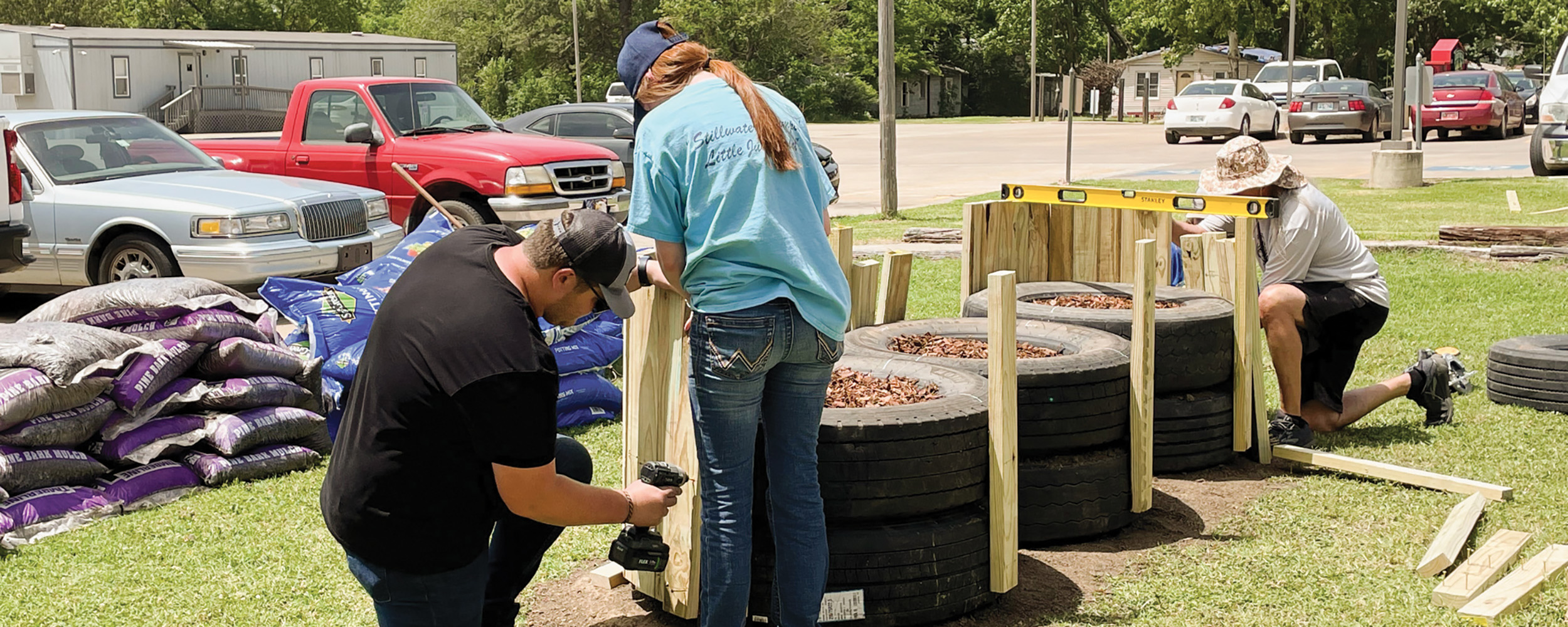
A New Spin on Gardening
Monday, January 9, 2023
Media Contact: Kaitlyn Weldon | Digital Communications Specialist | 405-744-7063 | kaitlyn.weldon@okstate.edu
On the outskirts of the Choctaw Nation in Hughes County, Oklahoma, you will find students at public schools and members of tribal senior citizen centers practicing three different “R’s” — reduce, reuse and recycle — with modular andeasy-access bed gardens constructed with used tires.
When Jim Shrefler, southeast district horticulture specialist, retired in 2021, Shelley Mitchell, associate extension specialist of youth programs in the Oklahoma State University Department of Horticulture and Landscape Architecture, inherited a Federally Recognized Tribes Extension Program grant through the U.S. Department of Agriculture.
The total amount awarded to OSU through the four-year FRTEP grant was $360,000. The grant was then extended by one year at no cost. This extra year allowed the department to continue working on the projects covered by the original grant for a fifth year.
“The grant was originally only meant to be valid for four years, but the government extended it a fifth year,” Mitchell said. “Jim asked if I would take it over.
“The grant specified it had to stay within the Choctaw Nation,” Mitchell added. “Because I am the youth horticulture specialist, I knew exactly what project I wanted the grant money to go toward the fifth year.”
The Choctaw Nation Reservation is 10,864 square miles located in southeastern Oklahoma and spans across 11 counties: Atoka, Bryan, Choctaw, Coal, Haskell, Hughes, Latimer, Leflore, McCurtain, Pittsburg and Pushmataha. The Choctaw Nation of Oklahoma is the largest of the three federally recognized bands of Choctaw Indians and is the third largest federally recognized tribe in the U.S.
Previously, Mitchell worked on OSU Extension projects at Choctaw Nation educational day camps. She was referred to Scott Robinson, community health director at Wewoka Indian Health Center. Mitchell said Robinson had completed projects at schools in Wetumka and Holdenville as well as the Holdenville Creek Indian Community Center and Wetumka Senior Nutrition Center, so they chose to build tire gardens at these locations.
The designs for these tire gardens were created by Steve Upson, a retired horticulture consultant with the Noble Research Institute in Ardmore, Oklahoma. After working with the institute for 34 years, this grant allowed Upson to keep busy during retirement, Mitchell said.
“Part of my job with Noble was developing new techniques for growing produce,” Upson said. “Using repurposed tires to create growing platforms was one of the projects that I worked on for many years.”
The idea for tire gardens and “lumber” made of rubber came about after concerns arose about the potential adverse health effects associated with the use of pressure-treated, arsenic-infused wooden lumber.
“People were looking for other options, and the alternative I came up with was tires,” Upson said. “Used tires are more affordable than traditional lumber because they are often free.”
Easy-access beds are garden beds lifted off the ground by stacking a row of tires. Modular style gardens are constructed by hollowing three identical tires and stacking them. Both of these garden bed styles are easier to use for those who cannot bend down or perform the physical tasks required for traditional gardening.
With student help from OSU and local high schools, volunteers built 20 modular gardens at Thomas Intermediate Elementary School and Wetumka High School. They also built an easy-access bed and five modular gardens at the Holdenville Creek Indian Community Center and Wetumka Senior Nutrition Center.
The gardens can teach Choctaw Nation citizens to grow and market culturally relevant crops.
Donna McGee, Wetumka Public Schools superintendent, said the positive impact of tire gardens can be seen throughout the entire school.
“The tire gardens have been so popular among the students,” McGee added. “They are so excited to see the growth and have the opportunity to eat the produce growing in the gardens.”
McGee said the enthusiasm in staff and students is present for the vegetable gardens to continue to be successful for years to come.
“The biggest benefit has been the collaboration between the high school botany class and the elementary science classes,” McGee said. “It has been fantastic seeing the older students mentoring the younger students when working in the gardens.”
Want your own tire garden?
The different tire garden models used in this project can be seen in The Botanic Garden at Oklahoma State University as part of the Backyard Garden Project.
Step-by-step instructions on how to construct different tire gardens can be found at oklahomagardening.okstate.edu/backyard-demo-gardens.
Source: “Oklahoma Gardening”
Story By: Charity Pulliam | Cowboy Journal
